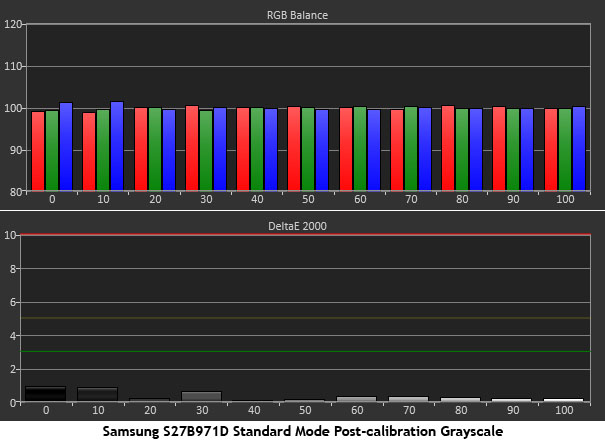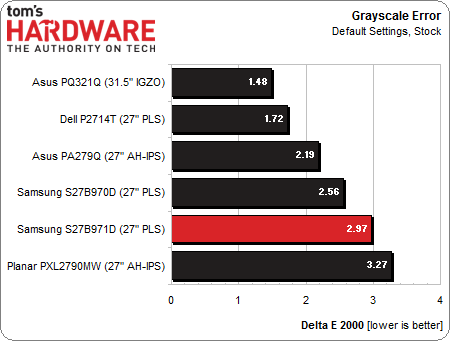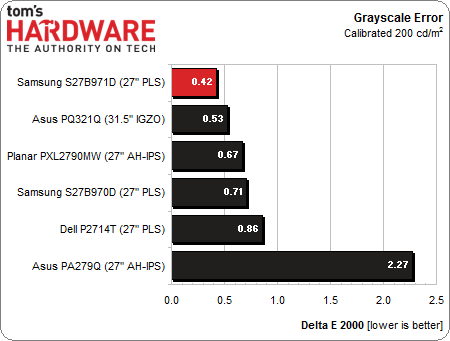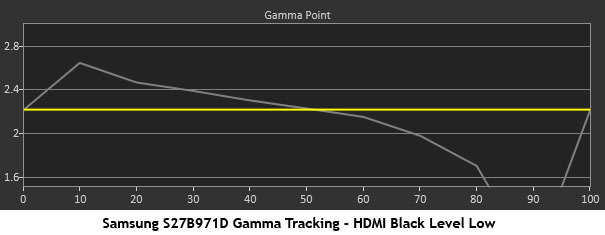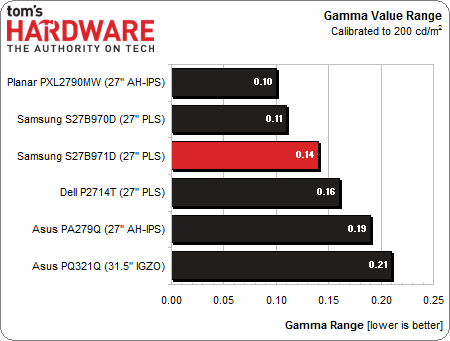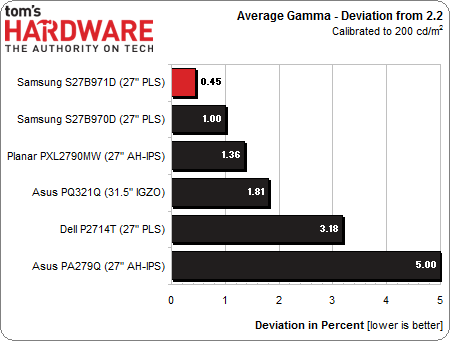Samsung S27B971D 27-Inch QHD Monitor, Reviewed
Samsung's S27B971D is a refreshed flagship 27-inch QHD monitor selling for $200 less than last-gen's model. It certainly looks impressive on paper, with its factory calibration and internal look-up table capability. Does it measure up in our lab, though?
Results: Grayscale Tracking And Gamma Response
A majority of monitors (especially newer models) display excellent grayscale tracking, even at stock settings. It’s important that the color of white be consistently neutral at all light levels from darkest to brightest. Grayscale performance impacts color accuracy with regard to the secondary colors: cyan, magenta, and yellow. Since computer monitors typically have no color or tint adjustment, accurate grayscale is key.
Given the S27B971D’s factory calibration and correspondingly-higher price, we are a little disappointed by the screen's out-of-box performance. We measured each picture mode and came up with similar results for all of them. There is a calibration data sheet included in the box. However, we couldn't duplicate those numbers without adjustment. You can see the color temp runs a little green as brightness rises. Errors are visible after the 50-percent mark.
Fortunately, a high-quality calibration is fairly easy.
This is a stupendous result, to say the least. The errors range from .11 to .98 Delta E, proving that a properly designed display can make do with just a single-point white balance control.
Here’s our comparison group again.
At default settings, the S27B971D is below average in grayscale performance. The S27B970D was only a little better.
After calibration, the 971 rockets to the top of the chart, besting its predecessor by almost .30 Delta E. Its .42 value is the best we’ve recorded to date for any display of any type.
Get Tom's Hardware's best news and in-depth reviews, straight to your inbox.
Gamma Response
Gamma is the measurement of luminance levels at every step in the brightness range from 0 to 100 percent. This is important because poor gamma can either crush detail at various points or wash it out, making the entire picture appear flat and dull. Correct gamma produces a more three-dimensional image, with a greater sense of depth and realism. Meanwhile, incorrect gamma negatively affects image quality, even in monitors with high contrast ratios.
In the gamma charts below, the yellow line represents 2.2, which is the most widely accepted standard for television, film, and computer graphics production. The closer the white measurement trace comes to 2.2, the better.
This graph was generated before we noticed the incorrect HDMI Black Level setting. We're not sure why Samsung has this at Low by default. Not only it hose the gamma curve, but it also crushes both highlight and shadow detail noticeably.
This is the gamma measurement at the Normal setting. It’s even better, if only slightly, than the graph generated by the S27B970D. Aside from a tiny dip at 10 percent, it’s perfect. And that dip represents a measly .33 cd/m2.
Here’s our test group again for the gamma comparisons.
A value range of .14 indicates extremely tight gamma tracking. And that is caused by only a single aberration at 10-percent brightness. As you can see, it doesn’t get much better.
We calculate gamma deviation by expressing the difference from 2.2 as a percentage.
Only three other displays we’ve reviewed can match this result: AOC’s I2757FH, HP’s ZR2740w, and Asus’ PB278Q. For all intents and purposes, this is perfect gamma response.
Current page: Results: Grayscale Tracking And Gamma Response
Prev Page Results: Brightness And Contrast Next Page Results: Color Gamut And Performance
Christian Eberle is a Contributing Editor for Tom's Hardware US. He's a veteran reviewer of A/V equipment, specializing in monitors. Christian began his obsession with tech when he built his first PC in 1991, a 286 running DOS 3.0 at a blazing 12MHz. In 2006, he undertook training from the Imaging Science Foundation in video calibration and testing and thus started a passion for precise imaging that persists to this day. He is also a professional musician with a degree from the New England Conservatory as a classical bassoonist which he used to good effect as a performer with the West Point Army Band from 1987 to 2013. He enjoys watching movies and listening to high-end audio in his custom-built home theater and can be seen riding trails near his home on a race-ready ICE VTX recumbent trike. Christian enjoys the endless summer in Florida where he lives with his wife and Chihuahua and plays with orchestras around the state.
-
cats_Paw 1000 dollars for a monitor 27 inch... nah.For that you can get a huge plasma TV if its for single player or a 300 dollar 27 inch monitor and use the 700 on something else.I still cant understand how companies expect to sell those expensive monitors to anyone but art/graphics/textures developers who actually need that picture quality.Reply -
c123456 @damianrobertjones: Do you know what comparable products cost? Apparently not. Look up a Dell U2713HM.Reply -
ubercake Contrast (even post-calibration) blows for that price. But you get a cool partially metal stand (?).Reply -
BoC_Gryphon To my knowledge, Toms has never done a review of the Korean 27" QHD monitors that can be had for ~$300-400. Please do.Reply -
Bolts Romano is it better than Apple Cinema Display in terms of color gamut and contrast?I wish i can find this monitor here in Canada so i can compare myselfSamsung Canada is very weird, it has its own flag stores here but it does not carry all the productsReply -
Bondfc11 You know this a pay to play for a review right? Of course Tom's doesn't do the korean models - or heck the Overlord Tempest lineup. What people don't get with QHD, and this includes Tom's staff, is LG has strict Tier 1 requirements for companies buying their panels that include minimum price points.Reply -
ceberle http://www.tomshardware.com/reviews/auria-eq276w-review-ips,3465.htmlReply
We covered the Auria EQ276W last April.
-Christian-

